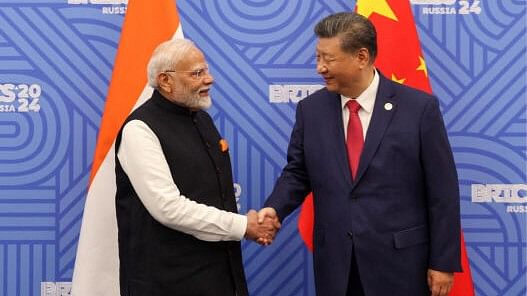
Indian Prime Minister Narendra Modi shakes hands with Chinese President Xi Jinping before their meeting on the sidelines of the BRICS summit in Kazan, Russia
Credit: India's Press Information Bureau/Handout via Reuters
By Ruchi Bhatia, Sudhi Ranjan Sen and Swati Gupta
After a 2020 border clash killed at least 20 Indian soldiers, Prime Minister Narendra Modi took a range of steps to block investment from China, even going further than the US in some areas. Now there’s a recognition in New Delhi that he may have gone too far.
Modi met Chinese President Xi Jinping on Wednesday at the BRICS summit in Russia, where the two leaders pledged to stabilize relations. Xi said both sides should strengthen cooperation and manage “differences and disagreements.” India said that special representatives from both sides would meet to plan next steps.
The 2020 border clashes, which also left an unknown number of Chinese dead, prompted India to impose strict rules on Chinese businesses seeking to invest in the country, ban hundreds of Chinese apps and slow visa approvals. The stringent measures led to the collapse of several investments proposals, including BYD Co.’s $1 billion plan to build electric vehicles in India.
Indian businesses have increased pressure this year on Modi’s government to relax the restrictions on China, according to officials familiar with the matter who asked not to be identified. It became clear, they said, that the tough stance on China was backfiring on Indian companies and hurting Modi’s push to attract more high-end manufacturing, including chipmakers.
India’s top economic adviser added to the debate in July, stating in stark terms that the South Asian nation needs to attract Chinese businesses to achieve the ambition of becoming a manufacturing hub. National security officials started to shift their stance around the same time, advising various ministries to take a “positive view” on investment proposals that posed no clear threat to India, the people said.
China had its own pressures as well, facing a more hostile world characterized by trade barriers and rising competition with the US over technology. Beijing in recent months has sought to improve ties with a range of countries, including American allies Australia and Japan, ahead of a US election that could bring back Donald Trump, who has threatened 60% tariffs on China.
Still, it’s unclear how far India will go in loosening its rules. Officials in Delhi said suspicion of China remains deep, and the move to improve ties is aimed at strengthening India’s economy over the long haul rather than making a strategic shift to turn its back on the US-backed Quad, which also includes Japan and Australia.
Indian Finance Minister Nirmala Sitharaman signaled on Tuesday that any easing of restrictions would be done cautiously. Speaking to a US audience, she said foreign investment needs “safeguards,” especially where it affects the “national interest.” She didn’t mention China specifically, but spoke in general about investment coming from neighboring countries.
India could start with moves to fast-track visas for Chinese technicians and add direct flights between the nations, according to officials familiar with the matter. Investment proposals would be cleared on a case-by-case basis, with preference given to Chinese manufacturing projects backed by government incentives, they said.
India is also considering a proposal to allow Chinese investment of as much as 10% in majority-owned Indian companies in sectors like electronics and electric vehicles, although restrictions would remain in place in sensitive areas like airports, defense and telecoms, a Finance Ministry official said, asking not to be identified.
At the same time, India is unlikely to remove a ban on major Chinese apps like TikTok or welcome firms such as tech giant Huawei Technologies Co., according to people familiar with the situation. Tariffs on Chinese goods also won’t be lowered, they said.
More immediate changes will be along the border, where the two sides are expected to pull back their troops and allow normal patrolling operations to resume. Subrahmanyam Jaishankar, India’s minister of external affairs, said that will help create the right conditions to take bilateral ties forward.
“It creates a basis for peace and tranquility in the border areas, which should be and was there before 2020,” he said on Monday. “That was our major concern because we always said that if you disturb peace and tranquility how do expect the rest of the relationship to go forward.”
Even with the investment restrictions, India’s economy has become more, not less, reliant on its bigger rival. China overtook the US as India’s largest trading partner in the fiscal year that ended in March 2024, with imports from China surging and India’s trade deficit ballooning to $85 billion.
As India grows its manufacturing, it’s also buying more inputs from Chinese suppliers: about a third of imports of electronics, machinery and chemicals and pharmaceuticals in 2023 came from China, according to Oxford Economics.
“The easing of India’s border problems with China is likely to rub-off on the economic relations between the two countries,” said Biswajit Dhar, a distinguished professor at New Delhi’s Council for Social Development. “The stage is set for greater participation of Chinese companies in India, both as investors and suppliers of a large range of manufacturing products.”